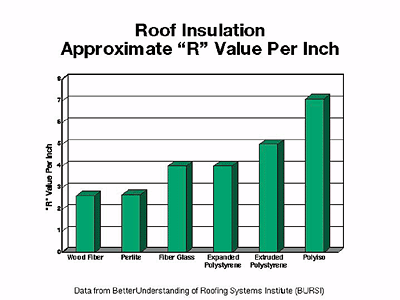From the Deck Up: Insulation

How much insulation do I need?
There are many factors that need to be considered in determining how much insulation you should use. According to the Corps of Engineer specification, insulation should have an overall transmission level of U=0.05 or an R-value of 20. You also need to weigh how much you will save in energy costs over the lifetime of the roofing system and compare that to the cost of the insulation. Minimum code requirements also play a role in the selection. And of course you need to keep in mind the economics of the overall project.
Generally, insulation plays the major role in providing energy cost savings. However, if the main cost consideration is to save on electricity during the summer, the type and color of the membrane should also be considered. The lighter the color and the smoother the surface, the more reflective the membrane will be.
Which insulation should I select?
The ideal product should have an efficient R-value and be strong and lightweight. It should be able to withstand temperature extremes and be adaptable to deck and membrane types. Cost is another factor that should be considered.
Insulations with the lowest R-values include wood fiber, perlite and gypsum. Insulations with intermediate R-values include foam glass, polystyrene, fiberglass roof insulation and mineral wool. The insulations with the highest R-value are iso and urethane (see chart).
Whatever insulation is selected, care should be taken to make sure the insulation is compatible with the roofing membrane.
What are the pros and cons of the insulations available?
Wood or Cane Fiberboard is an organic insulating board manufactured primarily of wood or bagasse (sugar cane fiber). These fibers are pulped and chemically treated and formed into a board. They may have additives or binders to increase strength, fire and moisture resistance. The benefits of wood fiber insulation are that it has a low installed cost, it is flexible and strong, and it has a stable R-value. It also performs well with mechanical attachment. However, the R-value is low, it’s heavy, has poor fire resistance and it is susceptible to moisture pick-up from the environment.
Perlite Aggregate Board is made from perlite volcanic ore that is expanded to increase its volume. It then may be coated with asphalt and combined with news pulp, starch binders and asphalt emulsion and formed into a board. The top surface of the board generally is coated with a sealer to control asphalt penetration during application of the membrane. It is acceptable for Class I construction, and can be secured to the deck mechanically. The perlite board is fire resistant, has good moisture resistance, excellent dimensional stability and generally acceptable mechanical stability. Its R-value, while stable, is low.
Gypsum Composite Products are typically paper-faced Type X 5/8-inch thick board used to obtain a one-hour fire-resistant classification. They offer fire resistance, strength and a good thermal barrier. But they are very heavy and have a low R-value.
Generally, the low thermal products (wood fiber, perlite, and gypsum) are used as substrates or in utility applications as coverboards to protect the insulation below it.
There are four insulations that fall into the mid-range for thermal value:
Foamed Cellular Glass is a rigid board made of closed-glass cells, bonded to form a block or sheet. It is water-resistant, noncombustible, and has good strength. However, foamed cellular glass insulations cannot be mechanically attached. They are also brittle, allowing freeze-thaw deterioration to take place at the surface of the board and continue into the product as each new surface is exposed. Since the kraft facings are organic, moisture can affect the bond with deck or membrane.
Polystyrene can be either extruded or expanded. It is lightweight, 100 percent recyclable and inexpensive. Unfortunately, polystyrene can melt at temperatures as low as 180°F, which means it is extremely difficult to use with hot asphalt. It is also attacked by most solvent-based adhesives. It can be used on BUR in combination with more heat-resistant board insulation like perlite board. Some uses have been designed to overcome these problems by bedding it into lightweight concrete or putting the extruded polystyrene over the finished roof in an inverted roof system.
Fiberglass Board is a rigid insulation made of glass fibers bonded with an organic resin. The top surface is covered with kraft paper laminated to the board with asphalt. One of the greatest benefits of this product is its flexibility in recover systems over irregular surfaces. It also is fire-resistant and has a stable R-value. Compression from job traffic can cause fasteners to pop through the roof membrane so a special plate has been designed to accommodate this. Continued water exposure will affect the binder, so care must be taken as with all other roof insulations.
Mineral Wool, which is used infrequently, is made from melted basalt glass that is spun and blown into fibers and faced with a mat. It is fire-resistant, has a stable R-value and is very flexible. It is not as strong as some insulations, it absorbs water and it is somewhat difficult to handle.
The two high thermal insulations are iso and urethane:
Polyisocyanurate Foam (polyiso) is a rigid board insulation formed in the factory between two facers. These facers are designed to provide stability, control the foam thickness and most importantly, provide compatible surface attachment. The facers may differ for applications, however, in roofing, the majority of the facers used are fiberglass reinforced. Polyiso has a high R-value and is lightweight, fire-resistant and user-friendly. Polyiso is compatible with most roofing system applications and, according to the 1999 NRCA Market Survey, is the most widely used insulation product in the roofing industry.
While having the highest R-value of any of the insulation products, polyiso does face some long-term thermal loss. One should always use aged R-values when designing a roof specification.
Sprayed Urethane is a field-manufactured foam sprayed in place normally over an existing roof. It has a high R-Value, and is seamless, nonpenetrating and lightweight. However, it is difficult to apply, lacks thermal stability, is not as strong as some of the other insulations and must be coated to prevent UV degradation.
There are a number of considerations to bear in mind when selecting the appropriate insulation product for a roofing system. Different thermal resistances as well as adequacy as a substrate for roofing membranes are among the most critical decision criteria. Other important considerations may be energy-savings payback and thermal stability. All of these considerations should be taken into account when selecting the right insulation product for your job.
Looking for a reprint of this article?
From high-res PDFs to custom plaques, order your copy today!





